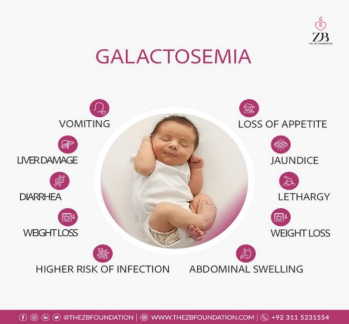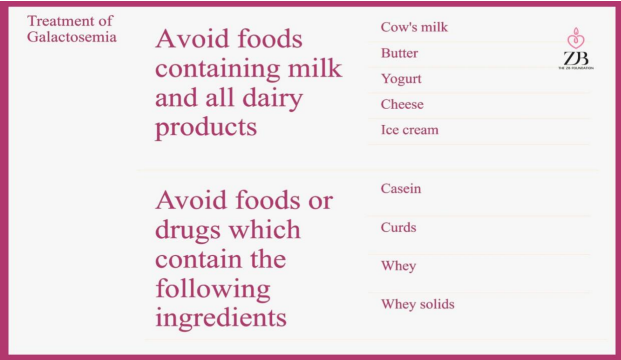GALACTOSEMIA
- What is Galactosemia?
Galactosemia is a rare genetic disorder that affects the body’s ability to metabolize the sugargalactose, which is found in milk and dairy products. There are three types of galactosemia:Classic galactosemia, which is the most severe form; Galactokinase deficiency, which is a milder form; and UDP-galactose 4-epimerase deficiency, which is the mildest form. Galactosemia is caused by mutations in the GALT, GALK1, or GALE genes, which encode enzymes involved in galactose metabolism.
2. What are the symptoms associated with Galactosemia?
Symptoms of galactosemia usually develop several days or weeks after birth. The most common symptoms include: • loss of appetite • vomiting • jaundice, which is yellowing of the skin and other parts of the body • liver enlargement • liver damage • fluid building up in the abdomen and swelling • abnormal bleeding • irritability • fatigue or lethargy • weight loss • weakness • higher risk of infection Babies who have galactosemia have problems eating and tend to lose weight. This is also known as failure to thrive.

3. How? When? And Why test for Galactosemia?
Galactosemia is usually diagnosed though tests that are done as part of Newborn Screening Programs. A blood test will detect high levels of galactose and low levels of enzyme activity. The blood is usually taken by pricking a baby’s heel. Genetic testing can also help diagnose galactosemia. Galactosemia can be detected through Newborn Screening. The screening test involves measuring the levels of galactose-1- phosphateuridyl transferase (GALT) activity in the blood. A positive result may prompt further testing to confirm the diagnosis. A galactosemia screening test is usually done to find out if a newborn has an increased risk of the disease. The test is done in the first few days after birth, as early as 24 hours after birth. In the diagnosis of galactosemia, the universal screening enables early dietary changes to prevent life-threatening clinical manifestations caused by high quantities of galactose.

4. What is the treatment of Galactosemia?
The only treatment for galactosemia is avoiding foods that contain lactose and galactose. A physician and a dietitian who specializes in metabolic disorders can tell you what modified dietary plan your child will need to follow. A person with galactosemia must avoid foods containing milk and all dairy products.

5. Statistics
- Galactosemia is a rare genetic disorder that affects approximately 1 in 30,000 to 60,000 newborns worldwide.
- Classic galactosemia is the most severe form of the disorder, accounting for approximately 75-85% of cases.
- Clinical variant galactosemia is a milder form of the disorder that accounts for approximately 10-15% of cases. Symptoms are typically less severe and may not appear until later in life.
- Biochemical variant galactosemia is the mildest form of the disorder and accounts for approximately 1-5% of cases.
6. References
- Padilla C.D., LamS.T. Issues on universalscreening for galactosemia. Ann. Acad. Med. Singap. 2008;37:6–9.
- Shah V., Friedman S., Moore A.M., Platt B.A., Feigenbaum A.S.J. Selective screeningfor neonatal galactosemia: An alternative approach. Acta Paediatr. 2001;90:948–949.doi: 10.1111/j.1651-2227.2001.tb02463.x.
- Randall J.A., Sutter C., Wang S., Bailey E., Raither L., Perfetti R., Shendelman S., Burbridge C. Qualitative interviews with adults with Classic Galactosemia and their caregivers: Disease burden and challenges with daily living. Orphanet J. Rare Dis. 2022;17:138. doi: 10.1186/s13023-022-02287-9.
- Kikuchi A., Wada Y., Ohura T., Kure S. The discovery of GALM deficiency (Type IV Galactosemia) and newborn screening system for galactosemia in Japan. Int. J. Neonatal Screen. 2021;7:68. doi: 10.3390/ijns7040068.
- Berry, G. T. (2021). Galactosemia. In GeneReviews® [Internet]. University of Washington, Seattle. Available from: https://www.ncbi.nlm.nih.gov/books/NBK1518/
- Lai, K., Langley, S. D., & Singh, R. H. (2020). Galactosemia. In StatPearls [Internet]. StatPearls Publishing. Available from: https://www.ncbi.nlm.nih.gov/books/NBK537343/

Leave a Reply